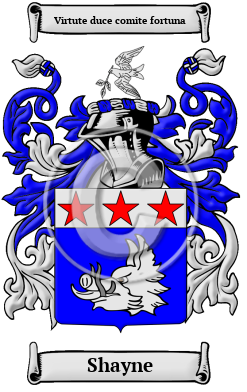| ![Show Contents]() Shayne History, Family Crest & Coats of Arms Shayne History, Family Crest & Coats of Arms
- Origins Available:
Scotland
England
Early Origins of the Shayne familyThe surname Shayne was first found in Aberdeenshire (Gaelic: Siorrachd Obar Dheathain), a historic county, and present day Council Area of Aberdeen, located in the Grampian region of northeastern Scotland, where they held a family seat from ancient times, some say as early as the 12th century. In this county the name has been found in the parishes of Fyvie, Drumblade, Auchterless, Culsalmond, Forgue, Turriff, Gamrie and King Edward. "A rare but old surname in Scotland. 'The surname of Shand seems originally to have been confined to the north-eastern counties, particularly Aberdeenshire, and in that county more especially to the districts comprising the parishes of: Turriff, Forgue, Drumblade, Auchterless, Culsalmond, Fyvie, King-Edward, and Garnrie." 1 The family is said, by C.F. Shand, the family historian, to be descended from Philibert de Shaunde, Earl of Bath in 1485, who in turn, was descended from a noble house in Normandy. The Earl of Bath, Philibert Shaunde, was created by King Henry II of England and Normandy. Philibert was styled by the King as "Consanguineus noster." 2 Further south in England, the Yorkshire Poll Tax Rolls of 1379 include: Johannes Schaune, Webster; and Thomas Shan. 3 Early History of the Shayne familyThis web page shows only a small excerpt of our Shayne research. Another 91 words (6 lines of text) covering the years 1522, 1551 and 1672 are included under the topic Early Shayne History in all our PDF Extended History products and printed products wherever possible. Shayne Spelling VariationsSpelling variations of this family name include: Shand, Chand, Schand, Chandai, Shandscross, Shawnd and many more. Early Notables of the Shayne familyMore information is included under the topic Early Shayne Notables in all our PDF Extended History products and printed products wherever possible. Migration of the Shayne familySome of the first settlers of this family name or some of its variants were: A. Shand who arrived in San Francisco, California, in 1852.
| Contemporary Notables of the name Shayne (post 1700) | + |
- Gloria Shayne Baker (1923-2008), born Gloria Adele Shain, an American composer and songwriter best known for composing the Christmas carol "Do You Hear What I Hear?" in 1962
- Shayne Philpott (1965-2024), New Zealand rugby union player who represented Canterbury at a provincial level, and was a member of the New Zealand national side, the All Blacks, between 1988 and 1991
- Shayne Courtwright, American actor, known for Cirque du Soleil: Quidam (1999)
- Shayne Whittington (b. 1991), American basketball player
- Shayne McCosh (b. 1974), retired Canadian professional ice hockey defenceman, brother of Shawn McCosh
- Shayne Greenman (b. 1969), Australian award winning artisan baker, sugar craftsman and culinary artist
- Shayne Hawke (b. 1988), Canadian professional wrestler
- Shayne McMenemy (b. 1976), Australian rugby league player
- Shayne Corson (b. 1966), retired Canadian professional hockey player
- Shayne Leanne Reese OAM (b. 1982), Australian medley and freestyle swimmer at the 2004 Summer Olympics
The motto was originally a war cry or slogan. Mottoes first began to be shown with arms in the 14th and 15th centuries, but were not in general use until the 17th century. Thus the oldest coats of arms generally do not include a motto. Mottoes seldom form part of the grant of arms: Under most heraldic authorities, a motto is an optional component of the coat of arms, and can be added to or changed at will; many families have chosen not to display a motto.
Motto: Virtute duce comite fortuna
Motto Translation: With valor my leader and good fortune my companion.
- Black, George F., The Surnames of Scotland Their Origin, Meaning and History. New York: New York Public Library, 1946. Print. (ISBN 0-87104-172-3)
- Lower, Mark Anthony, Patronymica Britannica, A Dictionary of Family Names of the United Kingdom. London: John Russel Smith, 1860. Print.
- Bardsley, C.W, A Dictionary of English and Welsh Surnames: With Special American Instances. Wiltshire: Heraldry Today, 1901. Print. (ISBN 0-900455-44-6)
 |

